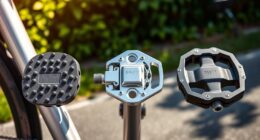Mini pumps are compact and ideal for quick, portable inflation, perfect for emergencies or on-the-go repairs. Frame pumps are larger, providing faster inflation with more control, suitable for bikes and larger objects. CO₂ inflators are quick and effortless, using compressed gas for rapid filling but need careful handling. Understanding these options helps you choose the best tool for each task—keep going to discover how each type works best for you.
Key Takeaways
- Mini pumps are compact, portable devices ideal for quick, on-the-go inflation of small items like bike tires or sports balls.
- Frame pumps are larger, efficient hand pumps designed for bicycles, offering higher volume and easier operation with ergonomic handles.
- CO₂ inflators use compressed CO₂ cartridges for rapid inflation, perfect for quick repairs or emergency tire inflation.
- Digital gauges on pumps provide precise pressure readings, preventing over- or under-inflation across different pump types.
- Combining ergonomic design with digital features enhances ease of use, accuracy, and safety in all inflation methods.

Pumps play a essential role in maintaining proper inflation levels, whether you’re filling up tires, sports equipment, or inflatable objects. When you’re inflating items, having a pump equipped with a digital gauge can make all the difference. Digital gauges provide precise pressure readings, so you know exactly when you’ve reached the ideal level. This accuracy helps prevent over-inflation, which can damage tires or balloons, and under-inflation, which reduces performance and safety. Using a pump with a clear digital display allows you to monitor pressure in real-time, saving you time and effort. Additionally, many modern pumps feature ergonomic designs that make handling easier, especially during prolonged use. They often include comfortable grips and lightweight construction, reducing fatigue and improving control. An ergonomic pump feels more natural in your hand, enabling you to apply steady pressure without strain, which is essential when inflating larger or stubborn objects.
Choosing a pump with ergonomic features isn’t just about comfort; it’s about efficiency. When your pump fits well in your hand and feels balanced, you’re less likely to make mistakes or exert excessive force. This can extend the lifespan of the pump itself and ensure consistent results. When combined with digital gauges, ergonomic designs empower you to inflate with confidence, knowing your pressure readings are accurate and your tool is comfortable to use. Whether you’re topping off bike tires, inflating sports balls, or filling inflatable pool toys, these features streamline the process. They also make routine maintenance easier, especially if you frequently check and adjust inflation levels.
In addition, many pumps with digital gauges come with features like auto-shutoff or preset pressures, which further enhance their usability. These functionalities allow you to set your desired pressure, and the pump automatically stops when it’s reached. This prevents over-inflation and saves you from constantly monitoring the gauge. Ergonomic designs complement these features by making it simple to attach the pump securely and operate controls intuitively. As a result, you spend less time fussing with the equipment and more time enjoying the inflated items. When you prioritize pumps with digital gauges and ergonomic designs, you’re investing in tools that deliver accuracy, comfort, and ease of use—making inflation tasks faster, safer, and more reliable.
Frequently Asked Questions
How Do I Choose the Right Pump for My Bike?
To choose the right bike pump, consider valve compatibility—make sure it works with your bike’s valve type. Also, think about pump portability; if you often ride single tracks or commute, a mini pump is handy. For regular riding, a frame pump offers easier inflation, especially for high pressures. Balance these factors based on your riding style and storage space to find the perfect pump for your needs.
What Is the Ideal Pressure for Different Tire Types?
Think of your bike tires like delicate musical instruments; the right pressure tunes the ride. For road bikes, stick to tire pressure standards of 80-130 psi, while mountain bikes need around 30-50 psi. Use ideal inflation tips by checking sidewall markings and regularly measuring pressure. Properly inflated tires improve performance, safety, and comfort, so adjust your pressure based on terrain and load to keep your ride in harmony.
How Often Should I Check My Tire Pressure?
You should check your tire pressure at least once a month to guarantee ideal tire lifespan and performance. Regular checks help you spot under- or over-inflation early, preventing damage and extending tire life. Also, make sure your pump is properly calibrated for accurate readings. If you notice inconsistent readings, recalibrate your pump to maintain correct pressure, which keeps your tires safe, efficient, and lasting longer.
Can I Use Co₂ Cartridges on All Bike Tires?
Think of CO₂ cartridges as a quick spark for your tire fire—they work well, but not on every tire. You can’t use them on all bike tires safely; check CO₂ safety and guarantee your tires are compatible. Some tires, especially delicate or high-pressure ones, may not handle rapid inflation. Always verify your tire type before using CO₂ cartridges to avoid damage and ensure a safe, efficient ride.
What Maintenance Is Required for Mini Pumps?
You need to regularly check your mini pump’s valve compatibility to guarantee it works with your bike tires. Keep the mechanism clean and lubricated to prevent rust and ensure smooth operation. Store the pump in a dry, cool place, avoiding extreme temperatures that could damage seals. Periodically test the pump to confirm it maintains proper pressure, and replace worn parts when necessary to keep it functioning effectively during rides.
Conclusion
Now that you understand the different pumps and inflation methods, you’re ready to hit the road smoothly. Picture yourself gripping that mini pump, feeling the steady push as you bring your tires to life. Or imagine the satisfying hiss of CO₂ filling your tires in seconds, ready for adventure. With these tools in hand, you’re all set to enjoy every ride, confident your bike is perfectly inflated and ready to roll on any journey that awaits.









